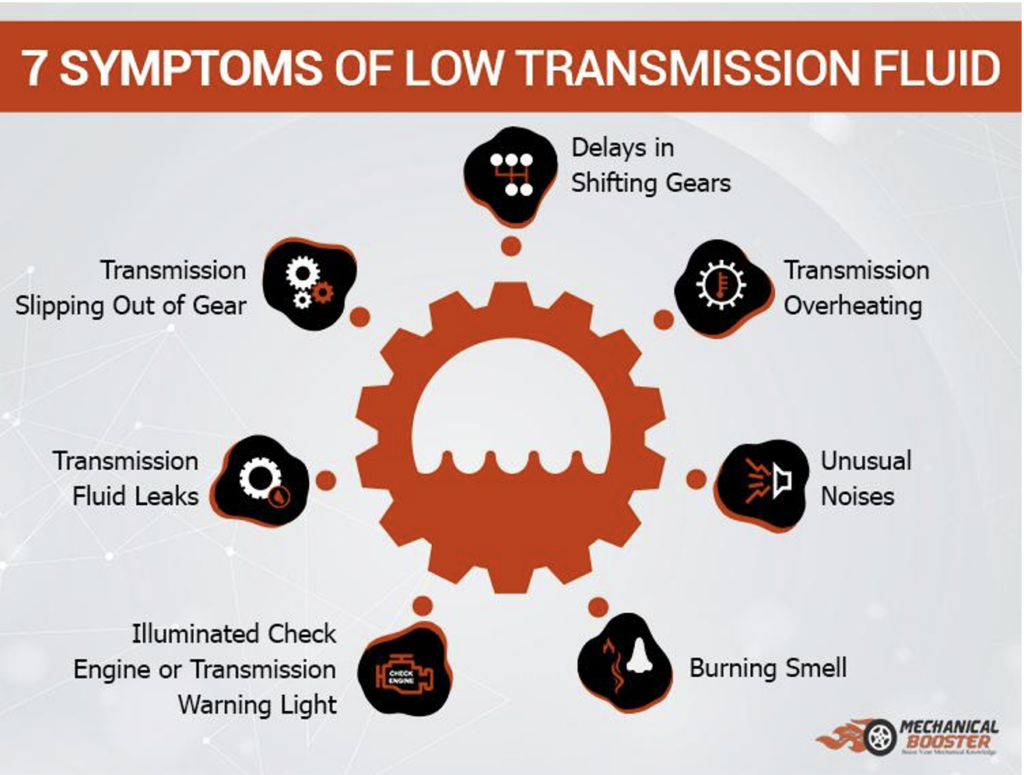Your vehicle’s transmission fluid is like a behind-the-scenes hero, working hard to keep your transmission system running smoothly. It acts as a lubricant, coolant, and hydraulic fluid, ensuring seamless gear shifts and a healthy transmission. But when the fluid levels drop, trouble can follow. In this article, we’ll explore the seven common symptoms of low transmission fluid and what they mean for your ride.
Get ready to learn valuable insights that’ll help you maintain peak performance for your transmission. Let’s dive in!

Common Low Transmission Fluid Symptoms
1. Delays in Shifting Gears
When the fluid level is low, the hydraulic pressure necessary for smooth gear transitions may be compromised. Inadequate fluid can prevent the proper engagement of gears, leading to delays or hesitation during shifting. Delayed gear engagement can also increase the risk of accidents, making it vital to address the issue promptly.
2. Transmission Overheating
Low transmission fluid levels can impair the transmission’s ability to dissipate heat effectively. Transmission overheating can result in severe damage to internal components and lead to costly repairs. If you observe your vehicle’s temperature gauge indicating high temperatures or experience frequent overheating, it is crucial to check your transmission fluid levels.
3. Unusual Noises
If you start noticing strange noises, such as whining, clunking, or humming, coming from your vehicle’s transmission, it could be an indication of low transmission fluid. Inadequate fluid levels can cause the internal components to grind against each other, resulting in unusual sounds. If you experience such noises, it is crucial to address the issue promptly.
4. Transmission Slipping Out of Gear
If your vehicle unexpectedly slips out of gear while driving, it could be a sign of low transmission fluid levels. The transmission relies on fluid pressure to maintain gear engagement. Inadequate fluid levels can result in a loss of pressure, causing the transmission to slip, potentially endangering both you and other drivers on the road.
5. Illuminated Check Engine or Transmission Warning Light
Modern vehicles are equipped with various sensors and warning lights to detect abnormalities. It is essential to understand the meaning of a warning light to ensure prompt action and maintain safety in various situations.
When the transmission fluid level becomes critically low, the onboard computer system may trigger a warning light on your dashboard. The check engine light or a specific transmission warning light could illuminate, indicating the need for immediate attention.
6. Transmission Fluid Leaks
Leaking transmission fluid is often an obvious sign of low levels. If you notice reddish or brownish fluid stains on your driveway or parking spot, it is likely that your transmission is leaking fluid, and immediate attention is necessary.
7. Burning Smell
A distinct burning odor emanating from your vehicle, particularly when the transmission is engaged, could be a sign of low transmission fluid. As the fluid diminishes, the remaining fluid becomes less effective in cooling and lubricating the transmission. This can cause the transmission to overheat, leading to a burning smell.
Conclusion
Maintaining proper transmission fluid levels is crucial for a smooth and long-lasting transmission system. Regularly check the fluid level and address any issues promptly to prevent costly repairs and ensure a reliable ride.
If you notice any of the seven common low transmission fluid symptoms mentioned above, it is advisable to consult a qualified mechanic or transmission specialist to diagnose and resolve the problem effectively.
Remember, early detection and intervention can save you from significant inconvenience and expenses down the road.

